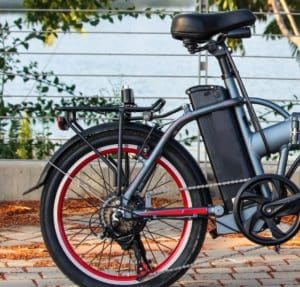
The battery in an electric bike is a major factor and without it, you cannot call your bike an electric bike, and therefore it is one of the most expensive components of an electric bike.
That is why it will not come as a surprise to you that an electric bike that costs 1500$ has a battery price between 300$ to 500$, so knowing how long Do Ebikes Batteries last? It is a very logical question especially if you are in the process of buying an electric bike or want to know the average lifespan in order to compare the expected lifespan of the ebike battery in general and your current battery.
In this post, we will discuss How long Do Ebikes Batteries last? In terms of life span and also in terms of charging, meaning that when you charge your electric bike battery, how much time or distance will the battery last?
Now let’s start by answering the question How long do Bikes Batteries last? In terms of general lifespan expectancy.
How long Do Ebikes Batteries last? (lifeSpan)
As a general rule, an electric bike battery can last between two to five years Which is the equivalent of 1000 full charges if it is well maintained.
Well, what I wrote earlier is the typical answer that you will hear from all cyclists or sellers, and it is a real answer, but the question here is what does it mean that the battery is properly maintained? because by knowing the answer to this question, you will be able to judge whether your battery works according to the expected lifespan or not.
For this, let us explain what is the healthy maintenance of the battery, or in other words, what you should do in order to increase the life span of the electric bike battery
1- Don’t fully discharge your ebike battery.
Most electric bike batteries are lithium batteries. Fortunately, lithium batteries do not need advanced maintenance, but the first piece of advice for you is not to wait until the battery is completely charged and then recharge it.
When the voltage is completely finished in the lithium battery, it does not work again properly. this is a True, but this does not mean that if you wait until the charge is completely finished, the battery will be completely destroyed, because every battery has a protection system called the BMS, and its main function is to completely turn off the battery when the minimum voltage is reached.
However, there is a risk because if anything happens that causes the battery management system to not work, there is a high possibility that the battery will be completely damaged if you wait for the charging to finish completely.
“Read Also, How Do You Discharge An Ebike Battery For Storage?”
2- Don’t ride your ebike in hot weather.
The next piece of advice relates more to the way you ride the bike itself. For example, if you ride your electric bike in a high-temperature atmosphere, you are likely to increase the heat emitted from the battery, which is produced as a result of chemical reactions that occur inside the bike. With this increase in temperature, the possibility of damaging a cell of the internal battery cells is high.
3- Don’t Ride your ebike in very cold weather.
This advice is the opposite of the second advice, but the goal here is the same, and the idea is that when you ride your bike in very cold weather, the internal environment of the battery is not completely suitable for the chemical processes inside the battery to take place, and therefore there will be a possibility of internal damage or that the battery performance is poor.
For more details about the causes of the ebike battery failure, you can see this post “Why Do Ebike Batteries Fail? (Explained)”
How long does an electric bike battery charge last?

After we have clarified the life span of the battery and the maintenance methods that should be followed, now we must know that what is the life span of a single charge, so that you can evaluate the performance of your battery or know the battery of your new electric bike is working well.
Due to the multiplicity of models and settings for electric bike batteries, which start from 24 volts to 57 volts, we will show a practical example so that you can understand what is the life span of a single charge.
The power of the battery depends on two main factors, volts and amps, and we will try to explain them in a very simplified practical way.
Volt is the electrical current leaving the battery
As for the ampere, it is the frequency with which this current goes out.
As an illustrative example: When you go to the gym, the muscle represents the battery and the weight you carry represents the volts and amps is the frequency of lifting this weight.
Multiplying volts and amperes equal the power that the motor will take from the battery.
If you have a 48 volt and 13 amp battery, the power is equal to 614 watts/hour (48v *13ambs=614w\h)
Now that we know the basics that determine the life span of a single charge, we must determine the other factors that affect the life span of a single battery charge.
Other elements affect the lifespan of a single ebike battery charge.
In the next section, we will explain other factors that can affect the life span of a single charge of an electric bike battery
1- Road Type.
The type of road is one of the main factors that can affect the extent to which you will get from charging your battery for one time, because when you ride your bike on a paved road, the friction coefficient will be very low, and therefore you will get a high speed of the electric bike and also exploit the full power of the motor and battery.
For example, in the previous example, if you rode the bike at a speed of 25 km / h and without using the pedal, you will get 25 km as an expected range in one charge.
On the contrary, if it is an inclined road, you will ride your bike at a speed of 15 due to the factors of gravity, friction, and the degree of inclination, and thus you will get an expected range of 15 km per hour.
Note: The figures are only illustrative and may differ on the ground.
2- Road Nature.
This factor is a complement to the road factor because the nature of the road greatly affects the speed at which you will ride your bike. For example, driving on muddy or rainy roads will require you to ride the bike at medium or low speeds, which reduces the expected range of a single charge.
Example: If you ride a bike on muddy roads, then most likely your bike speed will be between 10 to 12 km per hour, and if we assume that you use throttle without any help from you for an electric bike, then the expected range is about 12 km.
3-The wind.
If you are riding against the wind, the speed of your electric bike will be reduced due to the fact that you are riding against the current and therefore the expected life of the bike will be reduced if you do not use the pedal.
4- Pedaling.
The use of the switch to give is considered a major factor in increasing the life of a single charge of the battery. For example, in the previous example, we mentioned that if you have a 48-volt battery and 13 Amp, you will get 624 watt-hours.
And if you ride your bike at a speed of 25 km, you will get a range of about 25 km.
But if you decide to use the pedal at 50%, the watt-hour will be 312, then you will get a range of about 50 km while riding a bike at a speed of 25 km/h.
5-Tire Type.
The type of electric bike tire affects the life span of a single charge of the battery in terms of the coefficient of friction with the ground.
For example, if you have a fat wheel tire, this will increase the friction with the ground, which will reduce the speed unlike thin tires in which the friction coefficient is low and thus increase the overall speed of the bike.
Note: From my practical experience of owning a fat electric bike and one with a thin tire, the speed does not decrease by a huge percentage (about 20% based on the test I did, where I measured the speed difference between the two bikes at the same time)
6-Cyclist Weight.
The cyclist’s weight factor represents a difference in terms of the expected range of a single charge, because the greater the weight, the lower the speed at which the bike will go.
If you are a heavyweight rider You can see this post that lists everything you need to know before buying an electric bike.
Tables of the expected lifespan for a 48v, 36v & 52v battery.
After we have explained the other effects that may increase or decrease the life of a single charge of the battery.
I will share with you tables of the expected life of the 48v, 36v & 52v batteries if you use the Throttle only, and also with neutralizing the factors that affect the lifespan, in order to have a better expectation of the lifespan (range ) for every single battery charge with a different configuration.
Tables of the expected lifespan for a 48v battery.
The expected lifespan for a single charge of a 48v battery.
| Battery Volt | Ambs | watt\hr | Pedaling | Road type, nature & wind | Cyclist weight | Wheel size | Average Bike Speed | Excepted LifeSpan per one charge |
| 48 | 8 | 384 watt\hr | Top PAS assist or Full throttle | City Road, no wind | 160lbs to 220lbs | 26 | 20KM | 19.2KM |
| 48 | 10 | 480 watt\hr | Top PAS assist or Full throttle | City Road, no wind | 160lbs to 220lbs | 26 | 20KM | 24KM |
| 48 | 12.5 | 600 watt\hr | Top PAS assist or Full throttle | City Road, no wind | 160lbs to 220lbs | 26 | 20KM | 30KM |
| 48 | 13 | 624 watt\hr | Top PAS assist or Full throttle | City Road, no wind | 160lbs to 220lbs | 26 | 20KM | 31.1KM |
| 48 | 15 | 720 watt\hr | Top PAS assist or Full throttle | City Road, no wind | 160lbs to 220lbs | 26 | 20KM | 36KM |
| 48 | 17.5 | 840 watt\hr | Top PAS assist or Full throttle | City Road, no wind | 160lbs to 220lbs | 26 | 20KM | 42KM |
Table for the expected lifespan for a 36v battery.
The expected lifespan for a single charge of a 36v battery.
| Volt | Ambs | watt\hr | Pedaling | Road type, nature & wind | Cyclist weight | Wheel size | Average Bike Speed | Excepted LifeSpan per one charge |
| 36 | 13 | 468 watt\hr | Top PAS assist or Full throttle | City Road, no wind | 160lbs to 220lbs | 26 | 20KM | 23.4KM |
| 36 | 15 | 540 watt\hr | Top PAS assist or Full throttle | City Road, no wind | 160lbs to 220lbs | 26 | 20KM | 27KM |
| 36 | 17.5 | 630 watt\hr | Top PAS assist or Full throttle | City Road, no wind | 160lbs to 220lbs | 26 | 20KM | 31.5KM |
| 36 | 20 | 720 watt\hr | Top PAS assist or Full throttle | City Road, no wind | 160lbs to 220lbs | 26 | 20KM | 36KM |
Table for the expected lifespan for a 52v battery.
The expected lifespan for a single charge of a 52v battery.
| Volt | Ambs | watt\hr | Pedaling | Road type, nature & wind | Cyclist weight | Wheel size | Average Bike Speed | Excepted LifeSpan per one charge |
| 52 | 8 | 416 watt\hr | Top PAS assist or Full throttle | City Road, no wind | 160lbs to 220lbs | 26 | 20KM | 20.8KM |
| 52 | 10 | 520 watt\hr | Top PAS assist or Full throttle | City Road, no wind | 160lbs to 220lbs | 26 | 20KM | 26KM |
| 52 | 12.5 | 650 watt\hr | Top PAS assist or Full throttle | City Road, no wind | 160lbs to 220lbs | 26 | 20KM | 32.5KM |
| 52 | 15 | 780 watt\hr | Top PAS assist or Full throttle | City Road, no wind | 160lbs to 220lbs | 26 | 20KM | 39KM |
| 52 | 17.5 | 910 watt\hr | Top PAS assist or Full throttle | City Road, no wind | 160lbs to 220lbs | 26 | 20KM | 45.5KM |
| 52 | 28 | 1456 watt\hr | Top PAS assist or Full throttle | City Road, no wind | 160lbs to 220lbs | 26 | 20KM | 72.8KM |
In general, the life span of a single charge for an electric bike battery ranges between 20 km and up to 70 km, according to the battery configuration and the power of the motor, as well as other factors that may affect it, such as the use of the pedal, the type of road and wind, and the weight of the cyclist.
Conclusion.
As a general rule, the battery of an electric bike can last from 3 to 5 years, which is equivalent to 1,000 charges, taking into account the proper maintenance and riding the bike in the appropriate weather.
In general, a single charge of an electric bike battery can last for a range from 20 km to 70 km, according to the battery’s volts and amperes, and also taking into account other factors that may thrive in this range, such as the type of road and its nature in terms of slopes & hills, as well as the use of the pedal or not, the weight of the cyclist and the type of bike tires.
Useful Resources.
How To Carry Spare ebike Battery? this post shows creative ideas to carry your spare ebike battery.
How to Charge An Ebike Battery For The First Time? (Explained) This post shows step by step guide on how to charge your
new battery.
Can I charge My ebike With A Generator?(Explained) This post shows the correct ways to charge your ebike battery with generators as well as other energy sources that you may use to charge your ebike
External resources.
